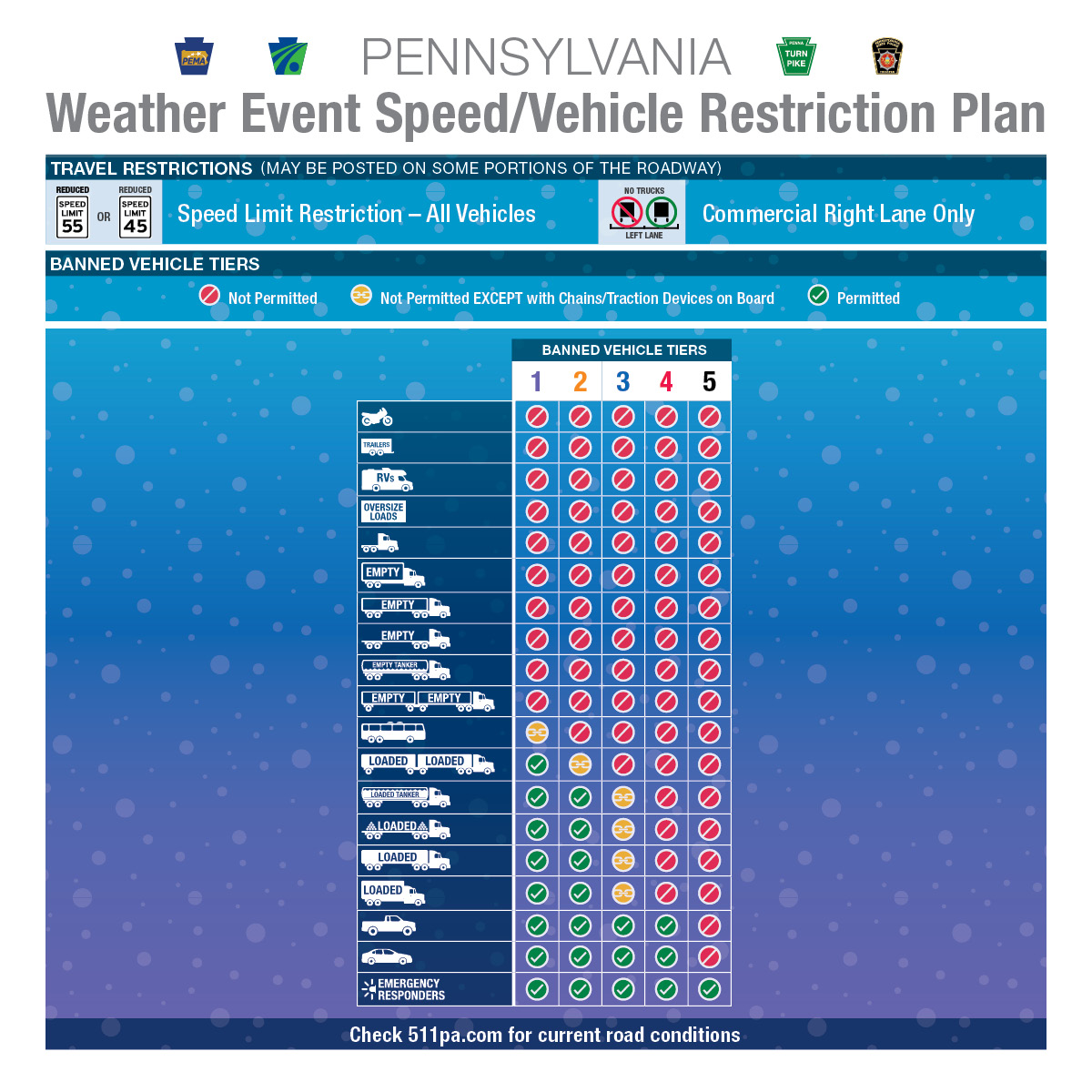Winter Event Vehicle Restrictions
Commercial Motor Vehicle (CMV) restrictions are a critical tool in preventing winter incidents that occur on Pennsylvania's interstate system, and in keeping the public, including CMV drivers, safe.
CMV accidents typically involve longer closure times as specialized equipment is necessary to remove the CMVs and typically some additional hazmat cleanup is necessary due to the larger fuel tanks and larger engines requiring additional fluids to run these vehicles.
Additional resources, such as volunteer fire and rescue personnel, are necessary to support vehicles, including CMVs trapped in the queue from these longer-term incidents.
CMV operators may be restricted from areas that do not appear to have adverse weather conditions to prevent them from entering areas with poorer conditions or to support other state's restrictions.
How Are Restrictions Determined?
PennDOT, the Pennsylvania State Police, and the Pennsylvania Emergency Management Agency assess each winter weather forecast to determine if CMV restrictions are warranted. Then, they review the restrictions hourly once they have been initiated to determine if the conditions warrant the restriction or can be lifted.
To view an overview of planned or active restrictions, a "Commercial Vehicle Restriction Info" tab will be available on
511PA.com.
Additionally, after restrictions are active, they can be viewed on
511PA.com under "Alerts" and "Weather Restrictions."
Commercial restrictions are lifted in a corridor approach to facilitate CMV movement once the restriction is safe to lift.
CMV restrictions are specifically designed to promote life safety of all motorists impacted by long-term closures.
We coordinate on these restrictions with neighboring states to minimize traffic impacts at the borders as much as possible (example, Pennsylvania may keep some of its restrictions in place longer because New Jersey still has its restrictions in place and CMVs and others may be traveling out of PA into NJ).
During weather events, the PA Business Emergency Operations Center (PABEOC) at PEMA is a helpful communications tool between state agencies and the private sector. The PABEOC is activated during many disasters. It is a clearinghouse of vital information such as road restrictions, waivers, and proclamations of disaster emergency, power status, and other information businesses need to make operational decisions. You can exchange information with other businesses and know there is a place with trusted, accurate information.
The PABEOC provides state-level information about restrictions and other event information through the dashboard and an email distribution list. Advanced event information can be found by accessing the
PEMA PA Business Emergency Operations Center website. All of the current restrictions, Governor's proclamations, and waivers are housed in this location. The website includes weather maps as well as the current restriction maps and specific communications to private industry.
There is also a working group of state and private partners called the Endeavor Group, which meets regularly to discuss private and state mobility concerns. If you are interested in participating, you can email
PABEOC@pa.gov or call PEMA External Affairs at 717-651-2739.
What Vehicles Are Restricted?
 Click to view larger.
Click to view larger.
CMV restrictions are issued in tiers based on the severity of the winter weather event.
Speed restrictions and right-lane-only travel restrictions for the following may be implemented independently or in conjunction with any of the tiered restrictions and restrictions listed below:
- All CMVs
- All passenger vehicles (cars, SUVs, pick-up trucks, etc.) towing trailers
Tier 1
- Tractors without trailers
- Tractors towing unloaded or lightly loaded enclosed trailers, open trailers, or tank trailers
- NOTE: A lightly loaded CMV is defined as a vehicle that is less than 1/3rd of the GVWR (vehicle weight and cargo weight combined)
- Tractors towing unloaded or lightly loaded tandem trailers
- Enclosed unloaded or lightly loaded cargo delivery trucks/box trucks that meet the definition of a CMV
- Passenger vehicles (cars, SUVs, pick-up trucks, etc.) towing trailers, to include:
- Recreational travel trailers and fifth-wheel trailers
- Enclosed cargo trailers
- Open cargo trailers
- Vehicle transport trailers
- Recreational vehicles/motorhomes
- School buses, commercial buses, and motor coaches without available chains or Alternate Traction Devices (ATDs)*
- Motorcycles
Tier 2
Tier 1, plus the following:
- CMVs towing loaded tandem trailers without chains or Alternate Traction Devices (ATDs)*
- All school buses, commercial buses, and motor coaches regardless of the availability of chains or ATDs
Tier 3
Tier 1 and 2, plus the following:
- All CMVs towing loaded tandem trailers regardless of the availability of chains or Alternate Traction Devices (ATDs).
- All other loaded CMVs except for:
- Those carrying full coverage tire chains for at least two drive wheels, or
- Those with approved Alternate Traction Devices (ATDs)*
Tier 4
Tier 1, 2, and 3, plus the following:
- All CMVs regardless of loading or availability of tire chains or approved Alternate Traction Devices (ATDs)
- Referred to as a complete CMV restriction
Tier 5
Tier 1, 2, 3, and 4, plus the following:
* Tire chains or ATDs do not need to be installed, but need to be readily available for use should the vehicle become stuck and not be able to move because of poor traction.
The only allowable exception to CMV restrictions are vehicles traveling for life/safety emergencies as a result of the storm, such as utility company vehicles responding to power outages. All exceptions must be coordinated through PEMA.